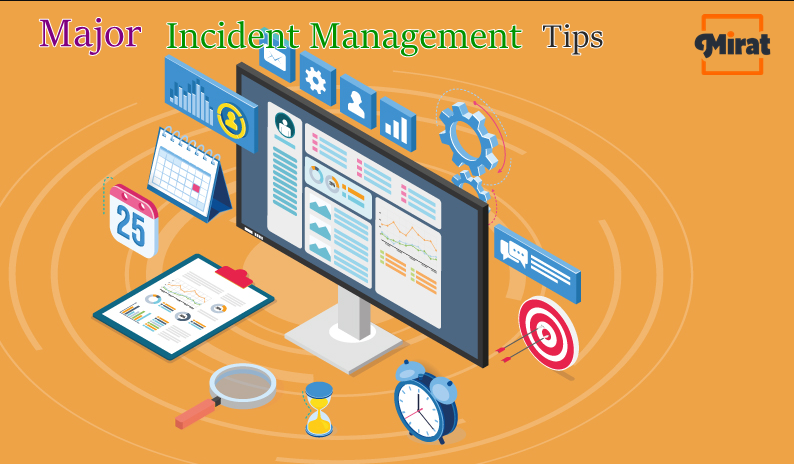MIRAT spills the beans!
Significant inconvenient occurrences cause hassle. Because of their negative impact on business operations and outcomes, they are known as the “boogeymen” of IT issues. Major incidents are also difficult to deal with by their very nature.
This occurs when an IT organization provides a service that the customer values and desires but cannot or does not want to provide themselves. Mirat.ai is one such platform that delivers all IT services.
For your convenience, we’ve compiled a list of seven essential major incident management best practices to get you started.
It’s Necessary To Double-check Any Information
As soon as you’re faced with a major incident, the first thing you should do is gather all the relevant information. The following are some important questions to ask in order to gain a better understanding of the situation:
- What kind of service are we talking about here?
- What does this have to do with the bottom line of the company?
- Who are the users who are impacted? Is it for everyone or just a certain group? Is it being looked at by a support team? Is the right team assembled?
- Is it necessary to alert other support groups?
- When did all of this start? A change in the political climate is possible, but what evidence do you have?
When you inform your customers and/or senior management of the problem, be prepared to answer all (or at least the majority of) of their questions.
Inform The Appropriate Individuals At The Appropriate Time.

Even in a perfect world your communications would be pre-planned, pre-scripted, and professionally delivered to the people who need to know in the event of a major incident.
It is, however, difficult to achieve perfection in all areas of one’s life. When a major incident occurs, make sure you have the appropriate individuals, the correct information, and the accurate timing ready to go.
To begin the process, let’s begin with who. It’s possible that you’ll have to communicate with any or all of the following people after a major incident:
- Customers who are fed up.
- Stakeholders and managers in the service delivery sector are tense.
- Technical teams are under pressure.
- Governing authorities
- The media.
Ensure that the correct individuals are conversing with the correct individuals. If, for example, you need to deal with external parties, you may want to consult with your compliance and legal departments.
Make your communications as clear and understandable as possible when you send them out. Make sure people know about any workarounds you know of.
Major incidents should contain the following information:
- Title and reference for the incident
- The impact on the bottom line of the company
- Affected service providers as well as their customers
- Is there a way to approach this differently?
- Information on how to get in touch with the customer care department
- The date of the next update.
Create an Action Plan
Begin putting together a plan of action with the help of your support team. Make sure you have all the key teams in place so that you can quickly figure out what’s going on.
As a Major Incident Manager, your service desk and support teams are your superheroes, swooping in to save the day.
You’ll frequently find yourself on a conference call or Skype session attended by a cast of thousands as you work through the fix effort. As a result, it’s imperative that the conversation remain on track.
You’re going for a quick, efficient, and kind tone here. Always keep in mind that people are under a lot of stress, and that things may not always be going as smoothly as you’d like them to. When dealing with a large number of parties, things can get tense.
Check in Frequently.
Keep the support teams and the company informed on a regular basis. If you say you’ll meet a deadline, then do so. In addition, don’t make people chase after you for updates; otherwise, they may bypass the major incident management process (part of ITIL 4) and go directly to the teams working on a fix, resulting in additional frustration and delays.
Involve Yourself In The Process Of Change.
Get someone else to double-check the solution and conduct some initial testing. To compound the problem, you don’t want a quick fix to go awry.
Help your resolving teams by assisting them in raising an emergency change and, if necessary, requesting an emergency change advisory board meeting. There are some companies that will allow the change to be raised retroactively so that the issue can be resolved immediately. Engage in change management (or change control, if ITIL 4 has been adopted) and do everything you can to make the fix effort go as smoothly as possible.
Let People Know That The Problem Has Been Solved.
Reminders for post-closing communications!
To ensure that the fix is working properly, contact some of the affected users to verify that the correct checks have been carried out. Provide an official statement that the (significant) incident has been resolved and that everything is back to normal once you have received confirmation.
Capture Any Lessons You’ve Learned During The Entire Process
As soon as the incident has been resolved, take five or ten minutes to document the most important steps taken and any lessons learned. You can do a more thorough review at a later time, but for the time being, take a few moments to document the most important events so that nothing is overlooked.
Schedule a short review meeting after everyone has finished their BAU work, eaten, and is sufficiently caffeinated. As major incidents require root cause analysis and possibly lessons learned to prevent the issue from occurring again in the future, this can be done in conjunction with your problem management and continuous improvement teams.
Mirat.ai makes sure everyone knows they are in a safe environment before it begins the review so that they can get an honest account of the event, any roadblocks, additional root causes and anything else that needs to be done to prevent it from happening again. As part of problem management and continuous improvement, ensure that any workaround information is entered into the appropriate database or wiki, and that opportunities for improvement are documented on the improvement register.
FAQs
What Is Incident Management In ITIL?
Incident management aims to minimize the negative impact of occurrences by promptly returning to normal service operations.
What is an IT Service Desk?
Keeping operations running smoothly is the primary goal of an IT service desk, which serves as the IT department’s operational arm.
IT service desks provide a single point of contact (SPOC) for IT users to easily communicate with the organization’s IT branch, handling everything from small individual technical issues to large-scale system outages.
What is Problem Management?
problem management : Managing incidents on an IT service means tracking down the root causes of those incidents and resolving them. In the ITSM frameworks, it is a fundamental component.
Mirat.ai’s IT Infrastructure Management is Affordable & Easy to use! Get your Dashboard ready in only 5 Minutes. Request for Trial/Demo now (or) Contact our Team Now .
Contact Information:
Hema
Sales Executive
Phone: +1-315-636-4213
Email: sales@mirat.ai
Website: https://www.mirat.ai/


